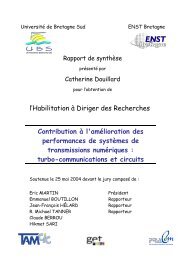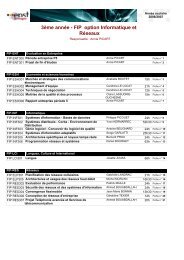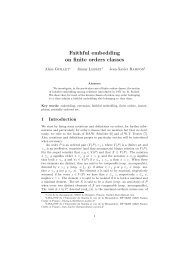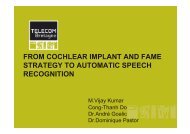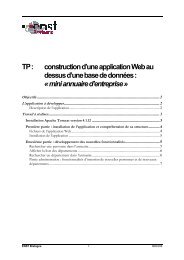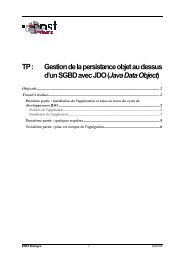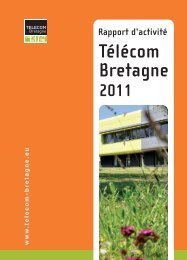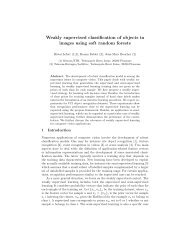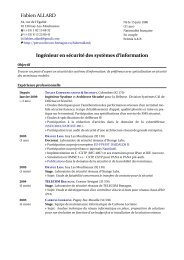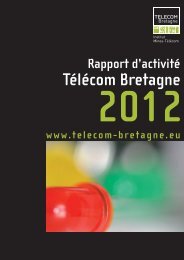researResearch - Télécom Bretagne
researResearch - Télécom Bretagne
researResearch - Télécom Bretagne
Create successful ePaper yourself
Turn your PDF publications into a flip-book with our unique Google optimized e-Paper software.
h Research<br />
9<br />
RESEARCH<br />
Main achievements of the project<br />
Enhancement and personalisation<br />
of professional off-line audiovisual<br />
contents<br />
The semim@ge project 's objective is the<br />
exploration and prototyping of access<br />
applications, and off-line, personalised use of<br />
enhanced professional audiovisual content. To do<br />
this, professional audiovisual programmes are<br />
off-line (fragmented) and indexed exclusively on<br />
the basis of a completely automatic and generic<br />
processing chain. This chain manages all the<br />
stages from ingestion to publication adapted to<br />
different distribution vectors and associated<br />
services using indexing by automatic generation<br />
of semantic and structural metadata.<br />
Two scenarios have been selected by ActuScan<br />
and TVPerso. The first led to the production of a<br />
demonstrator which uses this automatic<br />
processing chain and allows search and<br />
visualisation of the contents of televised news<br />
using indexing criteria. The second, which uses<br />
the services of the RVSP platform (Rich Video<br />
Services Platform), has been designed and put on<br />
line. It is an RIA (Rich Internet Application)<br />
developed in Flash technology which provides a<br />
user interface with enhanced graphics,<br />
interactivity and functions. The choice of this<br />
technology is mainly in response to our objective :<br />
to take advantage of the different multimodal<br />
analyses carried out by our partners, which offer<br />
new, innovative possibilities for access to<br />
audiovisual content. This was demonstrated<br />
during the project review at the ANR. The second<br />
will be implemented next year.<br />
For these two scenarios, supplementary indexing<br />
using semantic web technologies is under study.<br />
The semantic description of off-line audiovisual<br />
content requires us to establish the type of final<br />
users. In the project they are mainly the general<br />
public, all those who watch audiovisual content,<br />
broadcast on television channels today. We often<br />
use domain knowledge to model contents at the<br />
semantic level. This is very often expert<br />
knowledge, which would require good knowledge<br />
of the design and structuring of audiovisual<br />
content by users. It is clear that in our working<br />
context, it is not appropriate to apply such<br />
principles. On the other hand, the use of<br />
knowledge which is understandable to all seems<br />
quite adequate for our area of enquiry. In fact, we<br />
use general knowledge represented by<br />
« lightweight » ontologies, easily interpretable by<br />
the general public and thus useable (obviously by<br />
concealing the underlying complexity of the<br />
representations). This is the type of approach<br />
which has guided our work on semantic modelling<br />
of off-line audiovisual content.<br />
Recently, several on-line data sources, based on<br />
Semantic Web models and technologies have<br />
been developed. For instance, DBpedia offers a<br />
semantic web version of Wikipedia, created<br />
automatically by information retrieval. The whole<br />
data of this open source are available on-line in<br />
RDF format and can be explored in different ways.<br />
Freebase is another example of a source of free<br />
data on the Web, which offers users the possibility<br />
of adding data and developing the overall<br />
database design (creation of new types of data).<br />
Although they are often general, these sources of<br />
semantic web, free data are not universal. To<br />
allow wider coverage, links are established<br />
between different sources. These<br />
interconnections allow the establishment of a<br />
network of data sources covering very wide areas.<br />
This network is made up of general sources such<br />
as DBpedia and Yago, but also of many other more<br />
specialised sources, such as LinkedMDB, which<br />
is a semantic version of IMDB (Internet Movie<br />
Database). These data sources are created<br />
following free ontologies published on the web.<br />
These ontologies constitute the entry point for<br />
these semantic data sources, thus allowing the<br />
user to search and explore them and to navigate<br />
between them thanks to their interconnections.<br />
The aim is thus to enhance the description of offline<br />
content obtained automatically by our<br />
partners by adding a semantic level between the<br />
two demonstrators ActuScan and TVPerso. We<br />
will both offer content search functions which are<br />
more pertinent and more targeted towards the<br />
users' needs and enhance access to this content<br />
through other reliable, relevant sources of<br />
information.<br />
161<br />
1) CNES : Centre National d'Etudes Spatiales (National Centre for Space Studies)



